

AD Classics: Jewish Museum, Berlin / Daniel Libeskind. In 1987, the Berlin government organized an anonymous competition for an expansion to the original Jewish Museum in Berlin that opened in 1933.
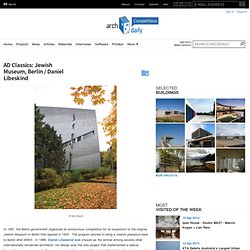
The program wished to bring a Jewish presence back to Berlin after WWII. In 1988, Daniel Libeskind was chosen as the winner among several other internationally renowned architects; his design was the only project that implemented a radical, formal design as a conceptually expressive tool to represent the Jewish lifestyle before, during, and after the Holocaust. The original Jewish Museum in Berlin was established in 1933, but it wasn’t open very long before it was closed during Nazi rule in 1938. Unfortunately, the museum remained vacant until 1975 when a Jewish cultural group vowed to reopen the museum attempting to bring a Jewish presence back to Berlin. AD Classics: Yatsushiro Municipal Museum / Toyo Ito. The city of Yatsushiro is known in Japan as a home for exemplary architecture – the legacy at least in part of Artpolis, a plan by the government of the Kumamoto Prefecture to seek out a range of talented architects to design cultural buildings in the cities of the region.

Though the Artpolis scheme has been running for the past 22 years, perhaps its most successful building was completed back in 1991, with the construction of Toyo Ito‘s Yatsushiro Municipal Museum. The selection of Toyo Ito for this particular project was seen as particularly risky, considering his commitment to contemporary and often technological design, as the site is directly opposite the historic Shohinken Villa and near to the ruins of Yatsushiro Castle.
However, Ito did not shy away from his progressive convictions, designing a sleek glass pavilion with a complex, billowing steel canopy. AD Classics: Kunsthaus Bregenz / Peter Zumthor. A year after the completion of Therme Vals [1996], renowned minimalist architect, Peter Zumthor completed the design of Kunsthaus Bregenz [1997].
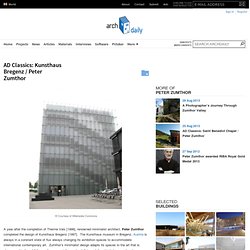
The Kunsthaus museum in Bregenz, Austria is always in a constant state of flux always changing its exhibition spaces to accommodate international contemporary art. Zumthor’s minimalist design adapts its spaces to the art that is showcased in its exhibits creating a coexisting and redefining relationship between art and architecture. AD Classics: Le Grande Louvre / I.M. Pei. In 1981, the newly elected French president, Francois Mitterrand, launched a campaign to renovate cultural institutions throughout France.
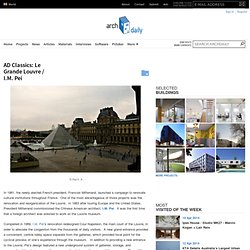
One of the most advantageous of those projects was the renovation and reorganization of the Louvre. In 1983 after touring Europe and the United States, President Mitterrand commissioned the Chinese American architect, I.M. Pei. AD Classics: East Building, National Gallery of Art / I.M. Pei. What would eventually become known as the West Building of the National Gallery of Art, the initial portion of the museum was financed by art collector Andrew Mellon.
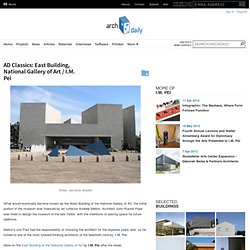
AD Classics: High Museum of Art / Richard Meier & Partners Architects. AD Classics: Miami University Art Museum / SOM. Known for their academic and institutional works that begin to integrate the academia with the outside world, SOM designed the Miami University Art Museum in Oxford, Ohio as an academic facility, as well as an art venue for the public to experience.

Situated on Miami University’s campus, the art museum enhances the universities cultural influence on the surrounding area by making Miami University the artistic and cultural center of Oxford. Completed in 1979, Walter Netsch and his team at SOM designed the museum as a responsive sculpture that appears to emerge from the elevated terrain and the surrounding wooded landscape. More on the Miami University Art Museum after the break. As part of universities requests, the museum was to be able to accommodate all types of art, and not just in a flexible space that adapts to the frequent gallery changes, but to hold all types of art simultaneously without one work or space overshadowing the next.
Architect: SOM Team: Richard Lenke, Walter A. AD Classics: Herbert F. Johnson Museum of Art, Cornell University / I.M. Pei. With a desire to make a dramatic statement while maintaining an optimal amount of scenic views, transparent open spaces and windows beautifully contrast the heaviness and boldness of the rectangular forms of concrete.

More on the Herbert F. Johnson Museum of Art at Cornell University by I.M. AD Classics: Kimbell Art Museum / Louis Kahn. Located in Fort Worth, Texas, the Kimbell Art Museum by Louis Kahn has become a mecca for all who are interested in modern architecture.

The element of natural light is the main focus of the design, and creates elegant spaces that are perfectly suited for the art that it houses. More on Louis Kahn and the Kimbell Art Museum after the break. The distinct form of the Kimbell Museum’s cycloid barrel vaults are rimmed with narrow plexiglass skylights, providing room for natural light to penetrate into the spaces. To diffuse this light, pierced-aluminum reflectors shaped like wings hang below, illuminating the smooth surfaces of the concrete vault while providing elegant and enchanting light conditions for the works of art. Three 100-foot bays that are each fronted by a barrel-vaulted portico comprise the main facade to the west, where the central entrance is marked by it’s glazing and recession from the rest of the facade. AD Classics: Whitney Museum / Marcel Breuer. Containing one of the most reputable collections of American art from the 20 and 21st centuries, the Whitney Museum designed by Bauhaus-trained architect Marcel Breuer is an easily recognizable landmark of Manhattan.

It is known for emphasizing exhibitions of work of living artists while also maintaining an extensive permanent collection of other important pieces from the first half of the century. More on the Whitney Musuem by Marcel Breuer after the break. The museum was founded by a well-regarded sculptor and art collector named Gertrude Vanderbilt Whitney, who had gained popularity among the art crowd after creating the “Whitney Studio Club,” which was an exhibition space for new avant-garde American artists. Upon collecting nearly 700 works of American art and being denied when she tried to donate the works to museums, Whitney felt the urge to start her own museum in 1929. This led to the conversion of three row houses to a larger gallery by architect Noel L. AD Classics: Museum of Modern Art, Gunma / Arata Isozaki. Considered one of Arata Isozaki’s greatest masterpieces, the Museum of Modern Art, Gunma stands as a testimony to Isozaki’s architectural ideology and represents a summary of his achievements.
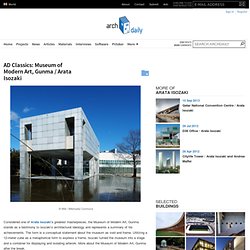
The form is a conceptual statement about the museum as void and frame. Utilizing a 12-meter cube as a metaphorical form to express a frame, Isozaki turned the museum into a stage and a container for displaying and isolating artwork. AD Classics: Vincent van Gogh Museum / Gerrit Rietveld. The Rijksmuseum Vincent van Gogh was commissioned in 1963, but not completed until over a decade later. Gerrit Rietveld was originally chosen to spearhead the project, and provided the initial design. Tragically, however, Rietveld died a year after the project began. Rietveld’s colleague on the project, J. van Dillen, took over the commission as a result, sticking closely to Rietveld’s previous sketches.
When van Dillen died in 1966, the project was finally left to be finished with a slightly adjusted design by J. van Tricht. AD Classics: The Museum of Fine Arts Houston / Mies Van der Rohe. After completing a master plan for the site in 1953, Ludwig Mies van der Rohe was commissioned by The Museum of Fine Arts Houston to do two additions to the Caroline Wiess Law Building. Cullinan Hall and Brown Pavilion were added in 1953 and 1974 respectively. AD Classics: Everson Museum / I.M. Pei. Architects: I.M. Pei Location: Syracuse, New York, United States Architects: I.M. Pei References: Wikipedia, Everson Project Year: 1968 Photographs: Jesse Ganes From the architect.
With a collection focused largely on American art and ceramics, the Everson Museum exists as a structure that is more than just a vault for art. Designed in 1968 by I.M. The building is primarily comprised of four opaque concrete volumes that surround an open atrium that visitors move through to access the galleries. Each volume contains galleries of differing size and height that when viewed from outside gives added hierarchy to the overall assemblage of forms that makeup the museum. AD Classics: Centre Le Corbusier (Heidi Weber Museum) / Le Corbusier. Iconic for its floating steel roof and brightly colored panels, the Centre Le Corbusier is the last building Le Corbusier designed before his death in 1965.
Completed in 1967, the building stands as a testament to Corbusier’s renaissance genius as an architect, painter, and sculptor. It does so both intentionally, as it is an exhibition space for his life’s work, and naturally, as it is a building masterfully designed. Interestingly, the building diverges in some ways from the style responsible for his renown – concrete, stone, uniform repetition, etc. It celebrates the use of steel, with which he explored prefabrication and assembly, and a freedom through modularity, in which the plan is completely open but infinitely adaptable. The building is composed of two major volumetric elements: a floating parasol roof-structure and beneath it, a two-story rectilinear volume sitting on a concrete pavilion floor. AD Classics: Menil Collection / Renzo Piano.
Most important Architectural additions to a city are those of spectacle, meant to stand out and grab attention, such as Frank Gehry’s Guggenheim Museum in Bilbao, Spain, or Daniel Libeskind’s extension to the Denver Art Museum. But when Renzo Piano made his American debut with the Menil Collection 25 years ago, the result was far from spectacle, but rather more supplementary to an already established neighborhood scale. AD Classics: Solomon R. Guggenheim Museum / Frank Lloyd Wright.